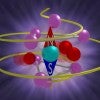2023-11-14 ライス大学
◆彼らの研究では、地球の地殻から化石燃料由来の炭素が侵食や風化を経て大気に放出されるプロセスが、山頂から氾濫平野まで高い割合で継続していることが示されました。これにより、地球の自然な炭素循環の理解が進み、気候モデルの精度向上と人為的な炭素排出の影響を軽減する効果的な戦略の構築に寄与する可能性があります。
<関連情報>
- https://news.rice.edu/news/2023/study-sheds-light-how-earth-cycles-fossil-carbon
- https://www.pnas.org/doi/full/10.1073/pnas.2306343120
アンデスの堆積物がアマゾンの前陸-氾濫原を通過する際に持続する、岩石有機炭素の高い酸化速度 High rates of rock organic carbon oxidation sustained as Andean sediment transits the Amazon foreland-floodplain
Mathieu Dellinger, Robert G. Hilton, J. Jotautas Baronas, Mark A. Torres, Emily I. Burt, Kasey E. Clark, Valier Galy, Adan Julian Ccahuana Quispe, and A. Joshua West
Proceedings of the National Academy of Sciences Published:September 19, 2023
DOI:https://doi.org/10.1073/pnas.2306343120

Significance
Erosion and weathering play key roles in Earth’s carbon cycle, controlling climate over millions of years by transferring CO2 to and from the atmosphere. Weathering of sedimentary rocks in mountains can release CO2 when ancient organic carbon in rocks is chemically broken down. However, mountain erosion also moves rock organic carbon that has not been broken down and is transported by rivers to lowland floodplains to an unknown fate. Here, we use rhenium in rivers to quantify rock organic carbon weathering in the Andes and adjacent floodplain. Erosion in the Andes leads to high rates of CO2 release. However, CO2 release doubles when including the floodplains. The presence or absence of floodplains next to mountains governs CO2 release by weathering.
Abstract
The oxidation of organic carbon contained within sedimentary rocks (“petrogenic” carbon, or hereafter OCpetro) emits nearly as much CO2 as is released by volcanism, thereby playing a key role in the long-term global C budget. High erosion rates in mountains have been shown to increase OCpetro oxidation. However, these settings also export unweathered material that may continue to react in downstream floodplains. The relative importance of OCpetro oxidation in mountains versus floodplains remains difficult to assess as disparate methods have been used in the different environments. Here, we investigate the sources and fluxes of rhenium (Re) in the Rio Madre de Dios to quantify OCpetro oxidation from the Andes to the Amazon floodplain using a common approach. Dissolved rhenium concentrations (n = 131) range from 0.01 to 63 pmol L−1 and vary depending on lithology and geomorphic setting. We find that >75% of the dissolved Re derives from OCpetro oxidation and that this proportion increases downstream. We estimate that in the Andes, OCpetro oxidation releases 11.2+4.5/−2.8 tC km−2 y−1 of CO2, which corresponds to ~41% of the total OCpetro denudation (sum of oxidized and solid OCpetro). A Re mass balance across the Rio Madre de Dios shows that 46% of OCpetro oxidation takes place in the Andes, 14% in the foreland-lowlands, and 40% in the Andean-fed floodplains. This doubling of OCpetro oxidation flux downstream of the Andes demonstrates that, when present, floodplains can greatly increase OCpetro oxidation and CO2 release.



